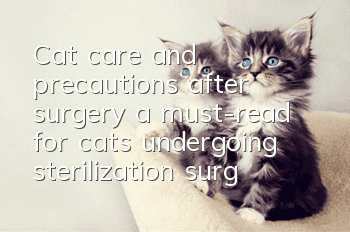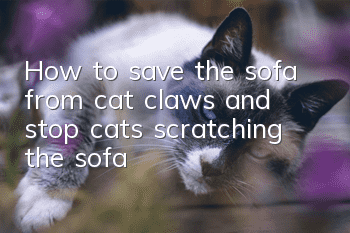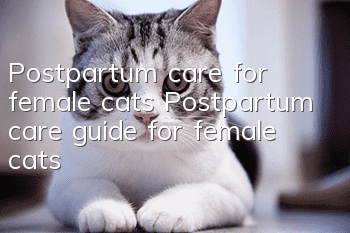Cat care and precautions after surgery, a must-read for cats undergoing sterilization surgery!

Cats need more care after surgery
The care and precautions for cats after surgery are a must-see for cats undergoing sterilization surgery! Cats are very fragile after surgery, and now general surgical operations require Inject anesthesia. Some anesthetics are very harmful to the cat's body. If you don't pay attention to observation and care after the operation, something will happen and a series of complications will occur. At the same time, the surgical wound also needs certain protection to heal faster.
When it comes to anesthesia for cat surgery, owners must pay attention. If there is gas anesthesia, it is recommended to use gas anesthesia. After all, gas anesthesia is safer. If you use injection anesthesia such as 846 mixture, the cat’s pulmonary edema will be really obvious after surgery. Too much, and in severe cases, the cat will die. Therefore, for the safety of the cat, the owner must choose carefully when it comes to anesthesia before surgery.
After the operation, the cat should lie flat on its side or be stretched out on the arms. If it must be placed in a bag, be sure to ensure that the airway of the head and neck is unobstructed; the body temperature regulation function of cats after sterilization surgery and anesthesia It will be affected. Pay attention to heat preservation in winter and heat dissipation in summer. Sleeping cats should not be placed in high places to avoid falling when they are not fully awake. Do not feed the cat after returning home on the day of the operation because the anesthetic has not worn off and the cat may eat it. If the cat is prone to vomiting, you can feed a small amount of water (the kind that wets your mouth) and put away the water bowl after drinking. If the cat has undergone sterilization surgery, the cat should not be allowed to eat 8-12 hours after the cat sterilization surgery and anesthesia to avoid damage to the gastrointestinal tract. . Generally, you can feed on the second day. Since you have been fasting for nearly two days, it is normal to not have a bowel movement for 1-2 days after the operation. Pay attention to observation. If you can eat and drink, and your bowel movements are normal, you don't need to worry too much.
Notes:
1. 3 hours after surgery is the period of high incidence of surgical complications, so it is recommended to stay in the observation room for at least 3 hours for confirmation. Leave the hospital after you regain consciousness and stabilize. During the observation period, the anesthesiologist will also formulate a corresponding infusion plan based on the animal's condition and pain level, so the observation time will also be determined based on the infusion time. Severe cases are recommended to be hospitalized for observation.
2. Try not to ask the doctor to give awakening injections, because many cats are allergic to awakening injections. Let the cat wake up naturally, which may take 3-6 hours; in the absence of awakening anesthesia after surgery, Be sure to keep the cat lying on its side with its neck straight to ensure smooth breathing
3. Just after leaving the operating room, the animal is still in a state of anesthesia and recovery. Although it has basic reflexes, it has not yet fully recovered. Therefore, do not feed before fully awakening to prevent vomiting or reflux and possible esophageal erosive damage or aspiration pneumonia. The complete awakening time varies depending on the animal and the severity of its condition, and generally takes 8-10 hours; please contact us for special cases. It is at the discretion of the doctor.
4. During the stay in the observation room, pay attention to keeping the respiratory tract open. You can let the patient lie prone or on his side with his head and neck stretched naturally. At the same time, observe the breathing status (the frequency and degree of the rise and fall of the chest, etc.) and the color of the tongue or mucous membrane. If there are any abnormalities, please contact your doctor promptly.
5. After surgery andUnder anesthesia, animals will be in a state of stress, showing symptoms such as trembling, moaning, and salivation. Pain management and owner comfort can relieve pain and reduce stress to a great extent.
6. Anesthesia and surgery will lower the animal’s body temperature. Please prepare comfortable nest mats and blankets to keep them warm. In addition, in order to prevent contamination from involuntary urination during the awakening period, a urinary pad can be laid on the nest pad. After bringing the cat home, do not place the cat in a high place such as a bed or sofa. Instead, place the cat in a nest on the ground or on a cotton pad. If the weather is cold, cover it with something; cats will stumble around when they are about to wake up from anesthesia. If you walk around randomly and drop it from a high place, it will open the wound.
7. During the recovery period, some animals will be irritable. They should wear collars in time to avoid unintentional injuries. They can also prevent scratching the wound after licking and biting to avoid infection after the wound cracks. When an animal becomes irritable, the owner must hold it or put it back in the cage to prevent it from falling or getting lost.
8. Follow the doctor’s instructions and get anti-inflammatory injections on time. If time does not allow and you don’t have time to get the injection, then you can take anti-inflammatory drugs at home, once in the morning and evening. Pediatric amoxicillin granules, open and pour 1 Mix an amount of /3 in a fresh bag or canned food, and the cat will eat it by itself (once in the morning and evening), and continue to feed it until the sutures are removed.
9. On the third day after the operation, remove the thick gauze that the doctor glued to the incision and only cover it with a surgical gown. Especially in summer, covering it too thickly for a long time can easily cause inflammation of the incision. . After removing the thick gauze on the third day, you need to check the incision every day, use cotton swabs dipped in iodine to disinfect the incision, and keep wrapping it in surgical clothes to prevent the cat from licking the wound and pulling threads. The stitches can be removed on the seventh day after surgery. One week after the stitches are removed, you still need to wipe the incision site with iodine every morning and night. Because the stitches have just been removed, the needle holes of the sutures have not grown properly, and infection can easily occur if you don't pay attention to hygiene.
- What should I do if my newly purchased cat goes hungry?
- What should I do if I have no cat food at home? If you don’t have cat food at home, what should you feed your cat first?
- 6 ways your cat admits it’s wrong, will you forgive it?
- Why does the cat not like to go to the pet store? It’s really hard for the cat!
- What should you pay attention to when repelling mosquitoes when you have pets at home? The harm of mosquito repellent products to cats
- Do cats need to be disinfected? What kind of disinfectant is safe to use at home with cats?
- Why does a cat suddenly become restless and lick its fur repeatedly?
- How much does it cost to vaccinate a cat?
- Are African Lion Cats Easy to Raise? African Lion Cat Feeding Plan
- What does it look like to detect cat plague?



